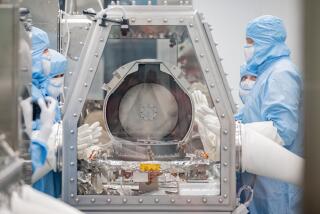Eureka! Complex organic molecules found in a young star system
Our solar system may not be as special as we thought. A new study of a young star’s protoplanetary disk finds the same kinds of complex organic molecules that are found on the comets in our own solar system.
The findings, published in the journal Nature, show that the same chemical building blocks that support the kind of life as we know it may regularly form around far-off stars.
“From my point of view, it’s really good news that we’re not that special,” said lead author Karin Öberg, an astrochemist at the Harvard-Smithsonian Center for Astrophysics. “We know that life originated somehow in the solar system — and it would be very exciting if it also originated somewhere else.”
“Having the same kind of chemistry present,” she added, “removes one more barrier to that being true.”
Scientists have long wondered what life around other stars, if it exists, might look like. Life on Earth is based around carbon and a handful of other key elements, including nitrogen, oxygen and hydrogen. But it’s unclear if the same kind of life-friendly chemistry has arisen on other worlds outside of our own backyard.
Öberg and her colleagues had been using a radio telescope array called the Atacama Large Millimeter/submillimeter Array in Chile to study a star system called MWC 480, which lies roughly 455 light-years away in the constellation Taurus.
MWC 480 is very young, and so it still has a wide disk of protoplanetary debris surrounding the star. The stuff in the protoplanetary disk will eventually coalesce to form planets, moons, asteroids, comets — the typical denizens of a fully fledged planetary system.
Our own solar system went through the same process, and so MWC 480 offers something of a snapshot into what our sun’s protoplanetary disk might have looked like before the planets were formed.
The scientists hadn’t been looking for signs of such complex organic molecules, Öberg said. But when they went through the data they found a surprising signal — one that appeared to be coming from cyanides, particularly complex cyanides. Along with the simplest molecule, hydrogen cyanide (HCN), they also found cyanoacetylene (HC3N) and methyl cyanide (CH3CN).
The discovery involved “a bit of luck,” Öberg said. “We weren’t actually looking for these complex organics.”
These chemicals were found pretty far from the star, ranging from about 30 to 100 astronomical units (also known as the Earth-sun distance), which is right around where icy comets should be forming out of MWC 480’s protoplanetary disk.
These types of molecules, made of carbon, nitrogen and hydrogen, are also found in comets in our own solar system. Comets, which reside so far from the sun that they’ve remained relatively unchanged, are fossils from our young solar system, when it was just 1 million to 10 million years old, Öberg said.
Comets might also have been among the vehicles that brought water and organic compounds to a young Earth, giving it the ingredients to start cooking up some primordial soup.
And while cyanides may not sound like a healthy sort of organic molecule, they’re highly reactive, Öberg said, and thus important precursors for pre-biotic chemistry. The carbon-nitrogen bonds in these chemicals, particularly in methyl cyanide, are crucial in the formation of amino acids, the building blocks of proteins.
“The molecules that are good for sustaining life are not necessarily the same ones that are good for the origins of life,” Öberg said. While cyanides, she added, “are of course very bad for life today … actually having cyanides there really helps that chemistry get going. So it’s a bit of a paradox.”
There are some key differences between this star and our sun, Öberg said. For one thing, the star is 1.8 solar masses and is putting out far more ultraviolet radiation than our sun does. But studying those differences can be useful for better understanding exactly how stars affect the chemistry taking place in their protoplanetary disks, Öberg said.
The work “demonstrates that protoplanetary disks are active engines of chemical synthesis, and that such environments are vital for building chemical complexity long before a planetary surface is created,” Geoffrey Blake of Caltech and Edwin Bergin of the University of Michigan, Ann Arbor, wrote in a commentary on the paper. “The potentially prebiotic chemistry traced by asteroids and comets in the Solar System is therefore replicated, at least in part, in other young planetary systems — suggesting that planets are supplied with these life-bearing elements as they are born.”
The next step, Öberg said, is to study the protoplanetary disks around other stars to see if the same sort of chemistry crops up around other stars.
“We definitely need a survey, since it’s difficult to know from a single system whether it was just luck or whether we saw it in the single system because it’s really quite common,” she said.
On the hunt for alien life? Follow @aminawrite for more science news.







